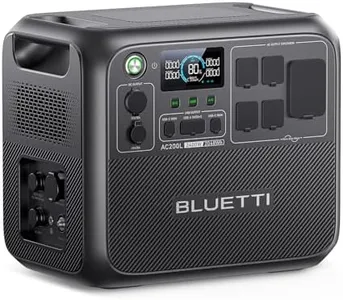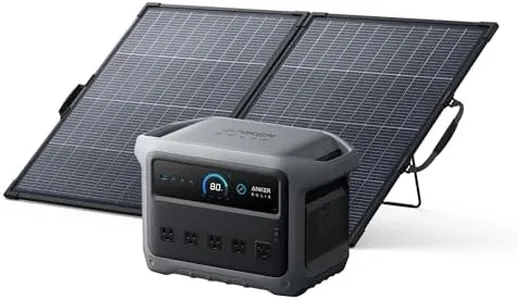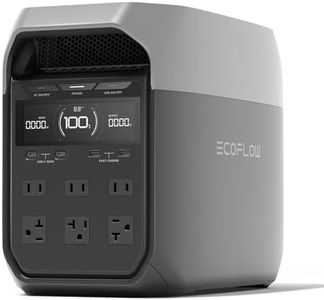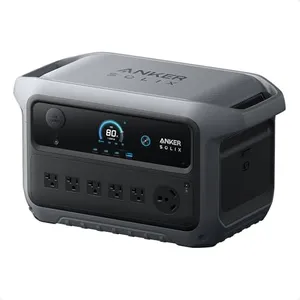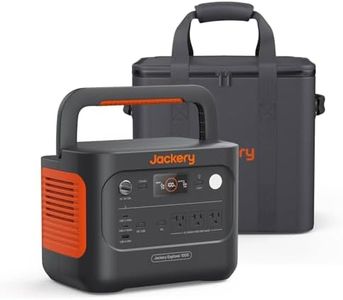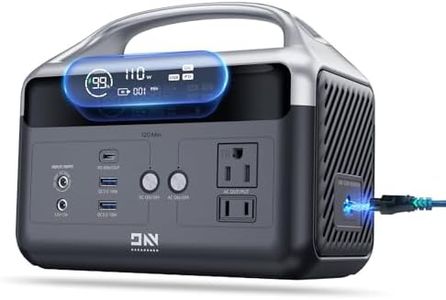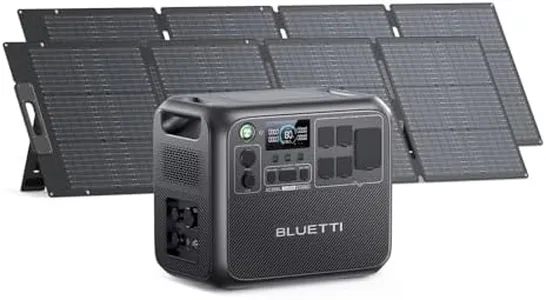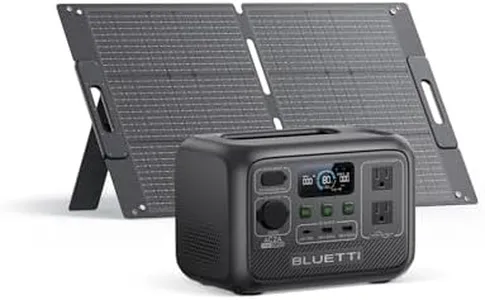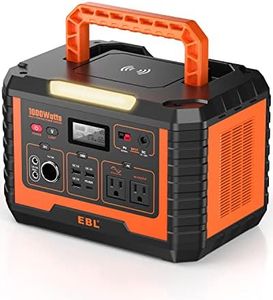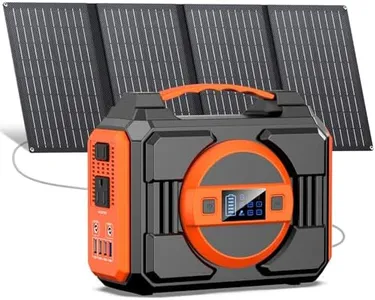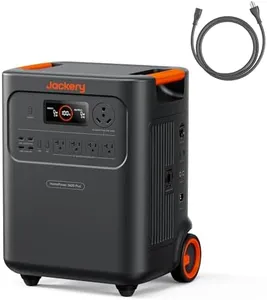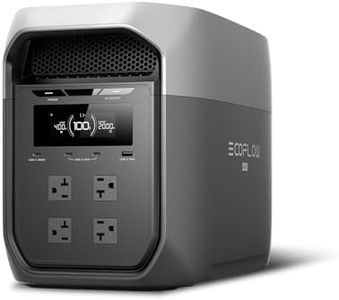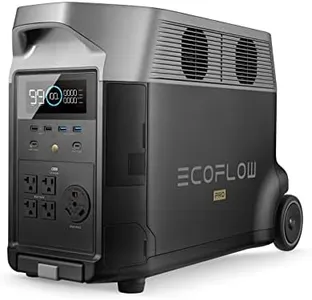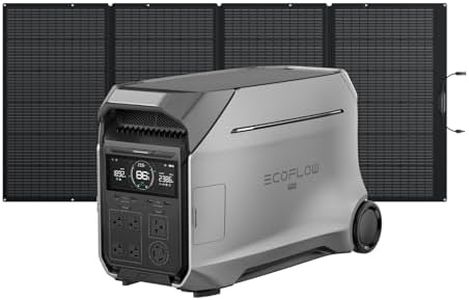10 Best Portable Power Station 2025 in the United States
Our technology thoroughly searches through the online shopping world, reviewing hundreds of sites. We then process and analyze this information, updating in real-time to bring you the latest top-rated products. This way, you always get the best and most current options available.

Our Top Picks
Winner
Anker SOLIX C1000 Gen 2 Portable Power Station with 200W Bifacial Solar Panel, 2,000W (Peak 3,000W) Solar Generator, Full Charge in 49 Min, 1,024Wh LiFePO4 Battery
Most important from
558 reviews
The Anker SOLIX C1000 Gen 2 is a solid choice if you're looking for a portable power station that packs a lot of power in a compact size. It has a 1,024Wh battery capacity, which means it can store a substantial amount of energy to keep your devices running for hours. With 2,000 watts of continuous power and a peak output of 3,000 watts, it can support multiple devices at once—up to 9 ports are available, so you can charge phones, laptops, small appliances, or even power outdoor equipment. One standout feature is its ultra-fast recharge time: using HyperFlash technology, the unit can fully charge in just 49 minutes from an AC source, which is much quicker than many competitors. It also supports solar recharging with the included 200W bifacial solar panel, taking about 1.8 hours for a full charge, making it great for off-grid use.
Portability is another plus—it’s lighter and smaller than similar models, weighing 29.5 pounds with dimensions that make it easy to carry and store. The battery uses LiFePO4 technology, known for durability and a long lifespan, promising up to 10 years or 4,000 cycles with 80% capacity retention, which means this power station is built to last. Additional smart features include a UPS backup with a very quick switchover time (under 10ms), useful for critical devices, and an app-controlled power management system that lets you schedule and monitor energy use to save on electricity costs.
One downside is that while 29.5 pounds is lighter than some competitors, it may still be a bit heavy for extended hiking or very casual use, and the price could be higher than simpler models due to its advanced technology and fast charging capabilities. This makes the unit especially suitable for campers, RV users, or anyone needing reliable, clean power on the go who values quick recharge times and battery longevity.
Most important from
558 reviews
EF ECOFLOW DELTA 3 Portable Power Station, 1024Wh LiFePO4 Battery, Full Charge in 56 Min, 1800W AC/100W USB-C Output, Solar Generator(Solar Panel Optional) for Home Backup Power, Camping & RVs
Most important from
7451 reviews
The EF ECOFLOW DELTA 3 is a powerful and versatile portable power station with a 1024Wh LiFePO4 battery, known for its long lifespan and durability, supporting around 4000 charge cycles with good protection against dust and water. It offers a strong 1800W continuous AC output and can handle surges up to 3600W using its X-Boost feature, allowing it to power up to 13 devices simultaneously – a solid choice for home backup or outdoor adventures. Charging is quick and convenient, with the ability to fully recharge in about 56 minutes via AC or solar panels (sold separately), and it supports multiple fast charging methods. Its modular design allows expansion up to 5kWh if you need more capacity down the line.
Weighing around 27.5 pounds, it’s portable enough for camping or RV trips but might feel a bit heavy for carrying long distances. The unit also runs quietly at low noise levels, making it suitable for quiet environments. On the downside, the initial cost and optional solar panel purchase can add up, and while it has many ports, some users might find the 100W USB-C output limiting for fast charging multiple modern devices. The system’s size and weight also mean it’s not the lightest option if you prioritize ultra-portability.
This power station is well suited for users needing a reliable, fast-charging, and expandable power source mainly for outdoor use or emergency backup, combining robust power delivery with durable battery technology.
Most important from
7451 reviews
BLUETTI AC200L Portable Power Station, 2048Wh LiFePO4 Battery Backup, Expandable to 8192Wh w/ 4 2400W AC Outlets (3600W Power Lifting), 30A RV Output, Solar Generator for Camping, Home Use, Emergency
Most important from
579 reviews
The BLUETTI AC200L Portable Power Station is a powerful and versatile option for those in need of a reliable source of backup power, whether for home use, camping, or RV trips. One of its standout features is the impressive 2048Wh battery capacity, which can be expanded up to 8192Wh with additional battery packs. This makes it highly adaptable to different power needs. The power station boasts a robust 2400W output, which is 200W more than its predecessor, the AC200MAX, and it supports high-demand appliances with ease.
For RV users, the inclusion of a 30A RV output port is particularly useful. Additionally, it offers a variety of ports, including AC, USB, car port, and a 100W PD port, ensuring compatibility with a wide range of devices. The fast recharge time is another significant advantage, with the capability to reach 80% charge in just 45 minutes using AC power, and full charge in 1.7 to 2.2 hours via solar input.
Its weight, however, at 61.4 pounds, may pose a challenge for portability, despite its compact dimensions. The durability and build quality are commendable, featuring a LiFePO4 battery known for long-lasting performance. On the downside, the high initial cost and the need for additional batteries to reach maximum capacity could be a consideration for budget-conscious users. The BLUETTI AC200L is a strong performer in the portable power station category, offering high power output, fast recharge times, and excellent expandability, making it ideal for users who require a reliable and versatile power source.
Most important from
579 reviews
Buying Guide for the Best Portable Power Station
Choosing the right portable power station can be a game-changer for your outdoor adventures, emergency preparedness, or even just for convenience around the house. A portable power station is essentially a large battery with multiple outlets that can power or charge various devices. To make the best choice, you need to consider several key specifications that will determine how well the power station meets your needs.FAQ
Most Popular Categories Right Now
